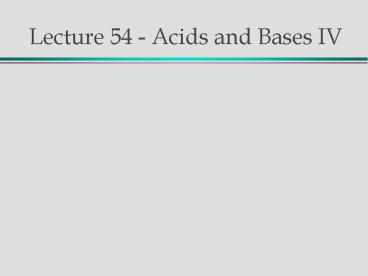Lecture 54 Acids and Bases IV - PowerPoint PPT Presentation
1 / 21
Title:
Lecture 54 Acids and Bases IV
Description:
Lecture 54 - Acids and Bases IV. Autodissociation of water can be ... e.g. Alizarin yellow. NO2. N - N = H =O. CO2H. NO2. N = N - -OH. CO2- OH- (RED) (YELLOW) ... – PowerPoint PPT presentation
Number of Views:80
Avg rating:3.0/5.0
Title: Lecture 54 Acids and Bases IV
1
Lecture 54 - Acids and Bases IV
2
Autodissociation of water can be significant...
- e.g. 1.0 x 10-7 M HNO3(aq)
- find pH !
- H3O(aq) from H2O H3O(aq) from HNO3
- but H3O ¹ 2 x 10-7
- 2 H2O(l) ¾ H3O(aq) OH-(aq)
equilibrium shift due to H3O from HNO3
3
Autodissociation of water can be significant...
- solution
- positive charge negative charge
- i.e. H3O (NO3- OH-)
- but, Kw H3O OH-
4
Kw
thus, H3O NO3-
H3O
thus, H3O2 NO3- H3O Kw
thus, H3O2 - NO3- H3O - Kw 0
since NO3- 1 x 10-7, H3O 1.6 x 10-7 M
pH 6.80
5
Acid Base Indicators
- are weak acids or bases themselves
- Hin(aq) H2O(l) ¾ H3O(aq) In-(aq)
Color A
Color B
6
Acid Base Indicators
i.e. ratio of colors changes with pH
7
e.g. Alizarin yellow
H
CO2H
N - N
O
(RED)
NO2
OH-
CO2-
N N -
-OH
(YELLOW)
NO2
8
Colors from Plants
Anthocyanins
9
The Common Ion Effect
- HF(aq) H2O(l) ¾ H3O(aq) F-(aq)
- NaF(s) H2O(l) ? Na(aq) F-(aq)
- F-(aq) is the common ion
equilibrium shifts, pH rises
10
The Common Ion Effect
- works for bases also
- NH3(aq) H2O(l) ¾ NH4(aq) OH-(aq)
- adding NH4Cl(s)
- NH4Cl(s) H2O ? NH4(aq) Cl-(aq)
equilibrium shifts, pH falls
11
The common ion effect
- e.g. 2.0 M HF(aq) had pH 1.4
- Add NaF(s) until NaF(aq) 2.0 M, find pH
- (Ka (HF) 7.2 x 10-4)
12
The common ion effect
- HF(aq) H2O(l) ¾ H3O(aq) F-(aq)
- NaF(s) H2O(l) ? Na(aq) F-(aq)
- Initial Equilibrium
- HF(aq) 2.0 2.0 - x
- F- 2.0 2.0 x (from NaF HF)
- H3O 0 x (from HF dissociation)
13
The common ion effect
x (2.0 x)
2.0 - x
x(2.0)
(x is small)
2.0
x
14
The common ion effect
- H3O x 7.2 x 10-4 M
- pH -log10 (7.2 x 10-4)
- 3.14
- (was 1.4 before addition of NaF)
15
Application of the common ion effect - buffered
solutions
- buffered solutions resist changes in pH
- e.g. blood pH is very constant at 7.4
a weak acid and its salt or a weak base
and its salt
a buffer
16
An unbuffered solution...
- 1.0 L H2O, add 0.05 mol NaOH, find pH
- pH 14 - pOH
- 14 - (-log10(0.05))
- 12.7
- (was 7.00 before adding base)
17
Buffered Solutions
- e.g. 1.0 L of 2.0 M HF(aq), 2.0 M NaF, pH 3.14
- now add 0.05 mol NaOH(s), find new pH
18
strategy...
- 1. react base with acid, some acid is destroyed.
- 2. residual acid re-equilibrates, find new pH
19
1. React acid with base
- HF(aq) OH- H2O F-
1 L x 2 M 2 mol
1 L x 2 M 2 mol
0.05 mol
initial
2.0 .05 2.05 mol
2 - 0.05 1.95 mol
0.0
final
20
2. Acid re-equilibrates
- HF H2O ¾ H3O F-
0
2.05
initial
1.95
x
2.05x
1.95-x
final
x(2.05)
1.95
21
2. Acid re-equilibrates
x(2.05)
x (2.05x)
7.2 x 10-4
1.95 - x
1.95
solving, x H3O 6.85 x 10-4
pH 3.16
(was 3.14 before adding base)































